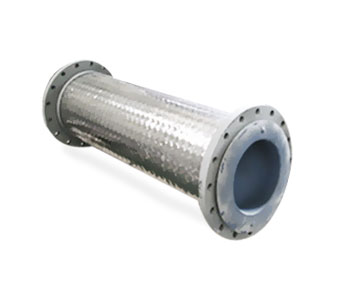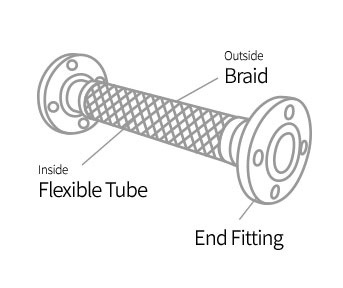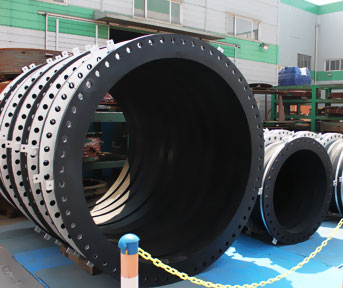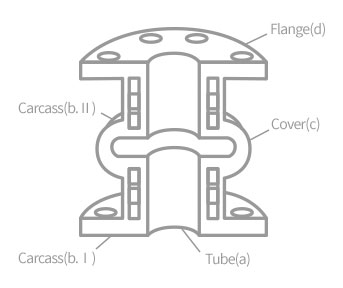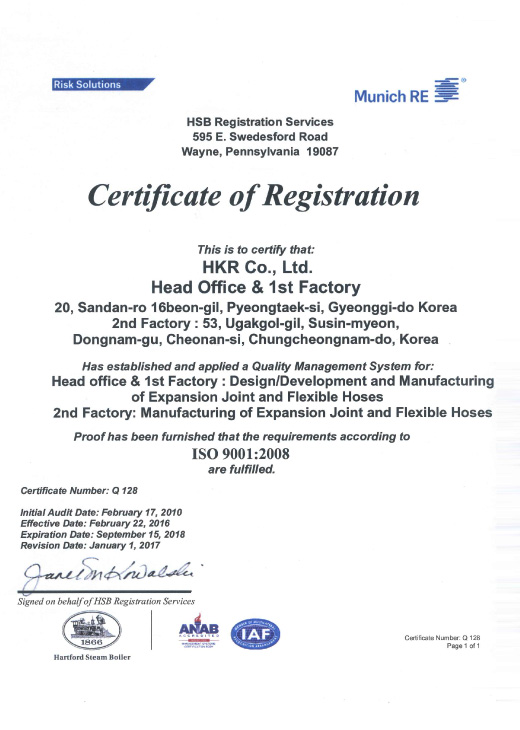Metallic Expansion Joint
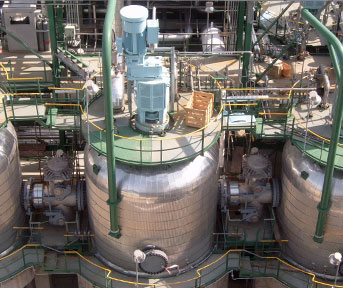
SINGLE TYPE EXPANSION JOINT-UN TIED (MSN)
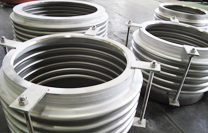
The simplest form of expansion joint, of single bellows construction, designed to absorb all of the movements of the pipe section in which it is installed. According to operated pressure of a device, this model is manufactured with or without the shrink ring.
SINGLE TYPE EXPANSION JOINT-TIED (MST)
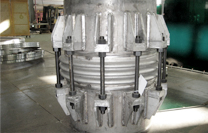
This model, with the tie-rod assembly, is an improvement on the Single Type Expansion Joint. This model is designed for pipelines with lateral movements. Tie-rods are designed to sustain the thrust generated during operation.
UNIVERSAL TYPE EXPANSION JOINT-UN TIED (MUN)
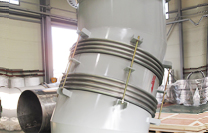
A universal expansion joint contains two bellows joined by a intermediate pipe for the purpose of absorbing any combination and angular rotation. This model is used for pipelines with bigger lateral movements than the single type.
UNIVERSAL TYPE EXPANSION JOINT-TIED (MUT)
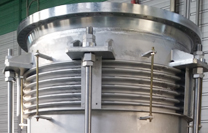
This model, with a tie rod assembly, is an improvement on the un-tied universal type. The tie rod absorbs the thrust, which may damage the device.
HINGE TYPE EXPANSION JOINT (MSH)
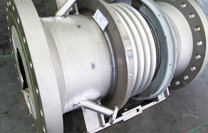
A hinged expansion joint contains one bellows and is designed to permit angular rotation, by the use of a pair of pins through hinge plates attached to the expansion joint ends. The hinge arms and hinge pins must be designed hinged expansion joints should be used in sets of two or three to function properly.
GIMBAL TYPE EXPASION JOINT (MSG)
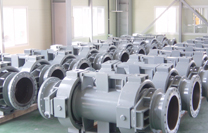
A gimbal expansion joint is designed to absorb combined movements by use of two pairs of gimbal arm and gimbal pin, which restrains the thrust of the expansion joints should be used in sets of two or three to function properly just like hinged expansion joints.
PRESSURE BALANCED TYPE EXPANSION JOINT (MSB)
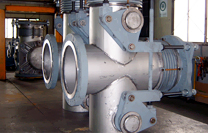
If the diameter of the pipe is excessively large or high pressure is running in the pipes, anchors must be installed to restrain the thrust of the expansion joint . However when conditions would not allow the installation of anchors, this pressure balance type expansion joint has to be used. According to the location of installation, L type (MSB-Bent Pipe Balanced) or S type (MSS-Straight Pipe Balanced type) is used.
RETANGULAR TYPE EXPANSION JOINT (MSQ)
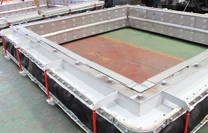
This product is designed to absorb heat expansion around large-scale rectangular line of high temperature and low pressure. This model is also designed to absorb movements and vibration of the dust collector, the exhaust duct, and the ventilator.
EXPANSION BELLOWS FOR HEAT EXCHANGER
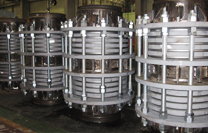
The expansion bellows for heat exchanger is used to restrain the heat stress, which is generated by temperature difference between the heat exchanger, the bellows prevent the heat stress from reaching the body or the tube.
CROSSOVER PIPE
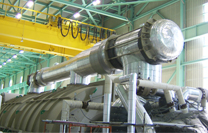
For the purpose of use for transfer the steam from LP Hood where steam turbine system. And it shall have suitable flexibility due to the different thermal movement between Turbine and casing. Also it shall have stability for the steam pressure when operating.
UNDERGROUND TYPE EXPANSION JOINT
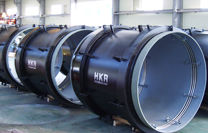
It is built to absorb the land pressures and seismic against the duct breakage because of the ground settlements and the earthquake shocks.
CRYOGENIC BELLOWS FOR LNG CARRIERS
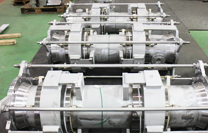
HKR designs & manufactures a wide variety of bellows type expansion joints rating from 3/8” to unlimited size of nominal diameter in accordance with the EJMA, ASME, IGC, GTT and special code required from customers. Our products for LNG Carriers are inspected and certified by LIyod’s Register, ABS, DNV, BV, KR, GTT.
Flexible Joint
[ Composition ]
Flexible metal hoses are manufactured from thin-walled, straight-bead welded stainless steel pipes by hydraulic or mechanical forming. They are absolutely suitable for high pressures and wide temperature ranges. The basic function of flexible connectors is to provide piping systems with the flexibility needed to absorb noise and vibration, compensate for thermal growth or permit motion of other piping elements
Composition
A Flexile hose is mainly consist of metal hose, braids and end fittings such as flanges, unions, nipples and sockets.
1) BraidWhen fluid pressure is under work inside the metal hose, the hose stretches length-wise. Should this occur, the brain restrains stretching and protects the metal hose from external shock. HKR's hoses are manufactured with stainless steel wire up to 200A. When manufacturing a braid, we always consider working pressure and temperature.
2) Flexible Tube (Metal Hose)Made of stainless steel strips, metal hoses are highly elastic. Corrugated forming methods enhance metal hoses' flex resistance and flexibility, reducing vibration at hoses by comprehensively processing stainless steel strips with the automatic forming machine and then heat-treating them in the automatic continuous bright suitable for general use under medium pressure and annular type, which is suitable for use under high pressure.
3) End FittingFlexible hoses are usually fixed by wilding end fittings to the ends of metal hose. The welding part is weak at corrosion than parent material because of heat stress. To address this problem, we manufacture flexible hoses to be as simple as possible to facilitate welding and assembly.
Flexible Hose- FHM
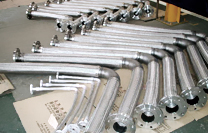
Flexible hose are the right solution for the transport of steam, gas, fluids and chemical agents for high temperature and pressure.
Pressure Range : 2 Kg/cm² ~ 20 Kg/cm²
Flexible Joint – FJM
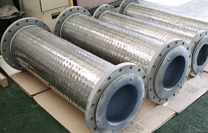
The product is small in length and flexible, it is used to connect the piping and equipment with small installation space and vibrational absorption.
Non Metallic Expansion Joint
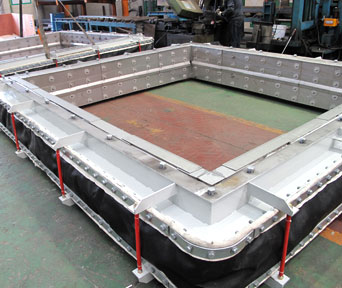
The non-metallic expansion joint are flexible connectors designed to eliminate the thermal stress created by absorption of displacement from thermal changes in ducting systems. It also absorbs vibrations and compensates for minor installation errors in its ducting or equipment. They are fabricated from a wide variety of non-metallic materials, including synthetic elastomers, fabrics, insulation materials and fluoroplastics, depending on the designs
Benefits
- Lower material costs
- Minimal shipping and installation costs
- Vibration reduction.
- Minimal field assembly requirements.
- Superior corrosion resistance
Application Area
- 1. Power Generation
a. Coal or Oil Fired Plants
b. Gas Turbine Plants
c. Cogeneration Plants
d. Nuclear Power Plants - 2. Pulp. and Paper Plants
- 3. Refineries :
a. Petro-Chemical
b. Chemical - 4. Steel Mills
- 5. Foundries
- 6. Smelters
- 7. Cement Plants
- 8. Kilns
- 9. Refuse Incineration
- 10. Marine
- 11. Vapor / Heat / Dust Recovery
- 12. Food Processing
- 13. HVAC(Heating, Ventilating and Air Conditioning)
| Connection method of product and duct | Structure |
|---|---|
 |
FF Type
|
 |
FW Type
|
 |
WLW Type
|
 |
MC Type
|
Rubber Expansion Joint
[ Composition ]
A flexible connector fabricated of natural or synthetic elastomers and fabrics and if necessary metallic reinforcements to provide stress relief in piping systems due to thermal and mechanical vibration and movement. Performance features include flexibility and concurrent movements in either single or multiple type construction, isolation of vibration and noise resistance to abrasion and chemical erosion.
Structure Detail
TubeLined with synthetic or natural rubbers to prevent leakage. Manufactured seamless from the inside to the end of a flange. Prevents holes in the body or weakening of fabric. These tubes can be designed to cover service conditions for chemical petroleum, sewage, gaseous and abrasive materials.
CoverOuter surface composed of synthetic or natural rubbers protects the frame from damage or severe conditions. Special polymer is resistant to oil, sunlight, acid fumes and ozone and it is additionally coated to protect the exterior surface.
CarcassConsist of fabric or metal reinforcement.
Fabric reinforcement :maintains tube and cover being flexible. Made of fine quality synthetic fabric but natural fabric used within acceptable temperature and pressure conditions. All fabric piles are impregnated with rubber or synthetic compounds to permit flexibility between fabric piles.
Metal reinforcement : wire or solid steel rings maintain the rigidity of the joint being inserted into the body. It extends the operational pressure range and ensures the product’s rigidity in vacuum service.
